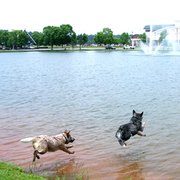Australian Cattle Dog
|
|
| Australian Cattle Dog | ||||||||||||||
|---|---|---|---|---|---|---|---|---|---|---|---|---|---|---|
| Alternative names | ||||||||||||||
| ||||||||||||||
| Country of origin | ||||||||||||||
| Australia | ||||||||||||||
| Common nicknames | ||||||||||||||
| Bluey, ACD, Cattledog | ||||||||||||||
| Classification | ||||||||||||||
| ||||||||||||||
| Breed standards (external links) | ||||||||||||||
| FCI - see ANKC, AKC (http://www.akc.org/breeds/australian_cattle_dog/index.cfm), ANKC (http://www.ankc.aust.com/austcat.html) CKC (http://www.nwstar.com/~acdcc/standard.htm), KC(UK) (http://www.the-kennel-club.org.uk/discoverdogs/pastoral/p835.htm), NZKC (http://www.nzkc.org.nz/br504.html),UKC (http://www.ukcdogs.com/breeds/herdingdogs/australiancattledog.std.shtml) |
The Australian Cattle Dog (ACD), also known as the Queensland Heeler, Blue Heeler, and Red Heeler, is a herding dog developed in Australia for handling cattle. It is a medium-sized dog with a lot of energy and an independent streak.
| Contents |
Appearance
The Cattle Dog's coat comes in a variety of markings, sometimes quite striking. The basic coat colors are blue and red speckle. For dog owners whose interest is primarily in their qualification for dog shows, even markings are preferred over uneven markings, and large solid-color marks on the body are undesireable. For owners who are more interested in their dogs' performance in activities such as herding or dog sports, the breed's strong work ethic and intelligence are of more importance than the exact coat markings.
The mask is one of the most distinctive features of an ACD. This mask consists of a darker red patch over one or both eyes (for the red speckle coat color) or a black patch over one or both eyes (for the blue coat color). These are called, respectively, single mask and double mask. ACDs without a mask are called plain-faced. Any of these is correct according to the breed standard, and the only limitation is the owner's preference.
Many Australian Cattle Dogs have a stripe of white hair in the center of the forehead, usually 1/2 inch to 1 inch by 2 inches to 3 inches (about 2 cm by 7 cm) called the Bentley Mark. This is similar in appearance to the blaze markings sometimes found on horses. According to legend, a popular dog owned by Tom Bentley passed on this distinctive mark to all Australian Cattle Dogs.
A female Australian Cattle Dog should measure about 17 to 19 inches (43 to 48 cm) at the withers. A male Australian Cattle Dog should measure about 18 to 20 inches (46 to 51 cm) at the withers. An ACD is a well-muscled, compact dog with a short, dense coat and a naturally long tail. An ACD in good condition should weigh roughly 40 to 50 pounds (18 to 23 kg).
Some breeders dock ACD's tails. This is a controversial practice and, in some countries, is illegal or is prohibited for dogs in the show ring.
Temperament
Like many herding dogs, Cattle Dogs have high energy levels and active minds. They need plenty of exercise and a job to do, such as participating in dog sports, learning tricks and practicing them daily, or other activities that engage their minds. Cattle Dogs who do not receive the appropriate exercise and entertainment will invent their own, often destructive, activities. Cattle Dogs are, by nature, timid or wary. They are naturally cautious, and grow more so as they age.
Cattle Dogs drive cattle by nipping at their heels. When around people, their instinct to herd is sometimes hard to suppress and they can nip at people to herd them. If these dogs will be around children, they and their owners must have sufficient training to know how to manage or avoid such situations.
Australian Cattle Dog activities
Australian Cattle Dogs not only tolerate a high level of physical activity, they almost demand it. Like many other herding dog breeds, they have active and fertile minds that turn mischievous if not properly channeled.
When not active, an ACD can be kept occupied with mental puzzles such as a Kong (http://www.kongcompany.com) stuffed with treats or a Buster Cube (http://www.sitstay.com/store/toys/toysd.shtml).

Among the most popular activities for Australian Cattle Dogs is dog agility. While the ACD is ideally suited for this work, since it is a herding breed and thus very reactive to the handler's body language, some ACDs become easily frustrated at the repetition and routine necessary to hone agility skills. As for many breeds, frequent brief training sessions are more effective than infrequent long training sessions. For this reason, many handlers find training an ACD to be challenging. It is important to always change the methods and exercises and not allow the dog or handler to get into a rut. ACDs thrive on change and new experiences.
Only a few ACDs, therefore, have excelled in obedience competitionFor example, the American Kennel Club awards an "Obedience Trial Championship" (OTCh) to the dog-and-handler team that defeats a large number of other teams in open competition. A handful of ACDs have reached this level. While ACDs enjoy the challenge of obedience competition, such as retrieving a scented article, the majority of ACDs are easily bored with precision drilling.
Dog Pictures and Clipart
- Pictures of Dogs (http://classroomclipart.com/cgi-bin/kids/imageFolio.cgi?direct=Animals/Dogs)
- Dog Clipart (http://classroomclipart.com/cgi-bin/kids/imageFolio.cgi?direct=Clipart/Animals/Dog_Clipart)
Clipart and Animal Pictures
- Clipart (https://classroomclipart.com/image/category/clipart.htm)
- Animal Clipart (https://classroomclipart.com/image/category/animal-clipart.htm)
- Animal Animated Clipart (https://classroomclipart.com/clipart/Animations/Animals.htm)
- Pictures of Animals (https://classroomclipart.com/image/category/animal-photos.htm)
- Amphibian Clip Art, Pictures and Photogaphs (https://classroomclipart.com/image/category/amphibian-clipart.htm)
- Farm Animal Clip Art, Pictures and Photographs (https://classroomclipart.com/image/category/farm-animal-clipart.htm)
- Mammal Clip Art, Pictures and Photographs (https://classroomclipart.com/image/category/mammal-clipart.htm)
- Marine Animal Clip Art, Pictures and Photographs (https://classroomclipart.com/image/category/marine-life-clipart.htm)
- Reptile Clip Art, Pictures and Photographs (https://classroomclipart.com/image/category/reptile-clipart.htm)
- Spider Clip Art, Pictures and Photographs (https://classroomclipart.com/image/category/spider-clipart.htm)







